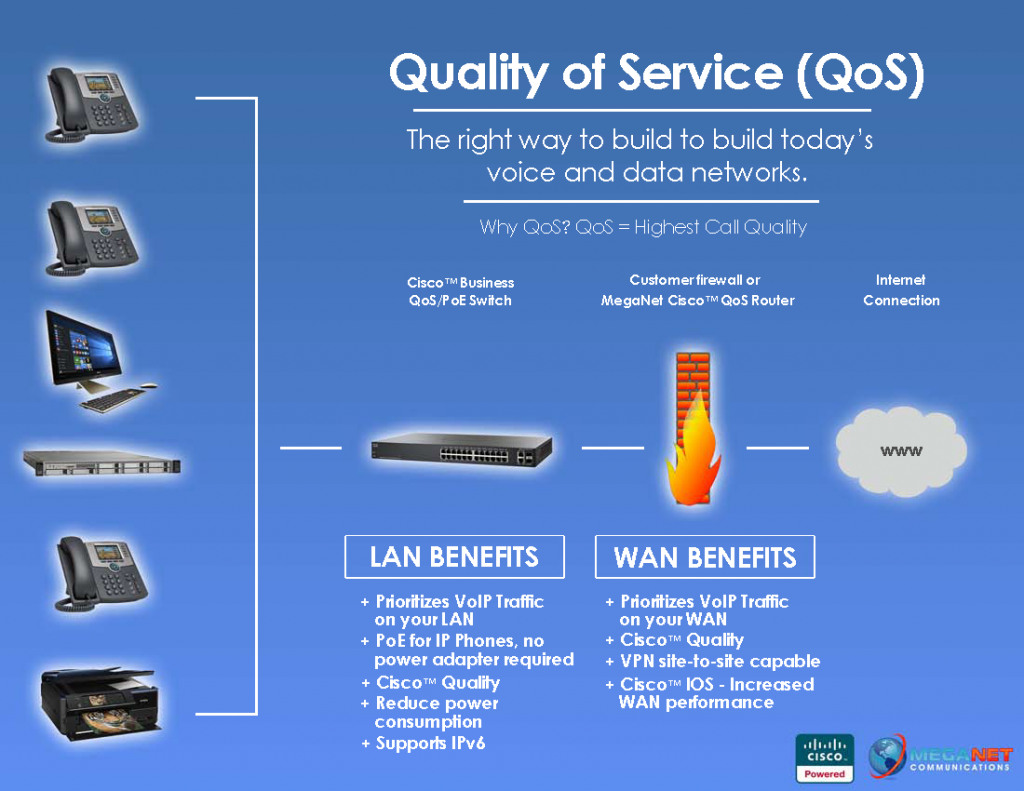Quality of Service, also known as QoS, is an important factor businesses need to consider when they are implementing a new Digital Voice or VoIP solution for their phone services.
 To break it down very simply, QoS is a network protocol that makes sure voice packets are given the highest priority within a local network, as well as at the edge of the customer’s network when it goes out over the Internet. Digital Voice and VoIP solutions often use an existing network and cabling that’s also shared with computers, servers, and other network devices. It’s important to make sure the voice packets are given the highest priority to make sure phone calls have the best quality.
To break it down very simply, QoS is a network protocol that makes sure voice packets are given the highest priority within a local network, as well as at the edge of the customer’s network when it goes out over the Internet. Digital Voice and VoIP solutions often use an existing network and cabling that’s also shared with computers, servers, and other network devices. It’s important to make sure the voice packets are given the highest priority to make sure phone calls have the best quality.
When other types of data packets are delayed or arrive out of order, users normally don’t notice any issues; maybe a website loads a bit slower, or an email takes an extra second or two to download, but that’s usually the worst case scenario. With Digital Voice however, when packets that comprise the phone call are delayed and arrive out of order, the call quality suffers – users will report an echo, squelch, or very tinny sounding calls.
QoS makes sure that all data packets that come from phones or PBX equipment are tagged as voice calls, and given the highest priority to make sure that they stay together as much as possible and aren’t delayed or sent out of order if the local network traffic is heavy.
Early adopters of VoIP services years ago may remember these types of issues were fairly commonplace and were one of the main complaints end users had. With faster Internet connections becoming more commonplace, the addition of QoS really helped Digital Voice quality rise quickly.
We always like to make sure our customers have QoS implemented on their network and normally consult with their IT department to make sure it’s enabled on their firewall or any edge routers. Recently we’ve also started offering a number of Cisco switches that not only provide QoS seamlessly with the Cisco Hosted PBX phones we offer, but they also provide Power over Ethernet (PoE) which allows the phones to be powered directly, without needing an additional power cord. This saves space and helps reduce power consumption.
Providing the Cisco switches has helped offer another layer of QoS on the customer’s network since the models we offer to clients auto-detect the Hosted PBX phones we provide as standard (the SPA 504G and SPA 508G, specifically) and will enable network-specific QoS to enhance call quality.
QoS isn’t just specific to Hosted PBX users either. Companies that use SIP trunking or IP-PRI services that share the same local network or Internet connection should always implement QoS to help their call quality as well.
Some clients with a high speed Internet connection may figure that since they have a lot of bandwidth QoS isn’t really necessary. What that line of thought doesn’t take into consideration is all the traffic on their local network – if users are accessing multiple servers and databases all day long, their Internet connection may have plenty of available bandwidth but their voice traffic is going to be fighting with all that local data traffic for space.
Digital Voice services have been a great boon to businesses of all sizes. Companies are saving money every month and becoming more productive with all the features offered by Digital Voice and Hosted PBX services. However one of those benefits (using an existing local Ethernet network) does have it’s pitfalls if QoS isn’t implemented properly. By making sure your local firewall and switches have QoS enabled, your phone calls will be crystal clear and in many instances may provide even better quality than traditional analog phone service.

